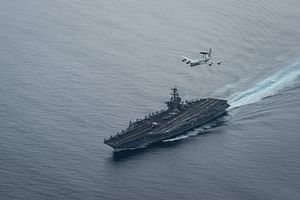The nuclear-powered Nimitz-class aircraft carrier USS Theodore Roosevelt, the flagship of the Theodore Roosevelt strike group, arrived in the U.S. territory of Guam on October 31 for a scheduled port visit, U.S. Pacific Command stated in a press release.
The USS Theodore Roosevelt left its homeport of San Diego, California on October 6 for a regularly scheduled deployment to the U.S. 7th and 5th Fleet areas of operations. The carrier entered the Western Pacific Ocean amid increasing tensions between the United States and North Korea over its ballistic missile and nuclear tests on October 23, the U.S. Navy announced in a separate statement.
“While in Guam, Theodore Roosevelt is planning to conduct multiple community relations projects, shipboard tours and sporting events,” the October 31 statement reads. “Sailors will also have the chance to experience highlights of the area and local sights through tours organized by the ships’ Morale, Welfare, and Recreation programs.”
It is the first time that the U.S. Navy supercarrier has visited Guam. The port call comes amid reports that China has practiced bombing runs targeting the U.S. territory with H-6K long-range bombers.
There are currently three U.S. Navy carrier strike groups — the USS Nimitz, USS Ronald Reagan, and USS Theodore Roosevelt — operating in the 7th Fleet area of operations, which stretches from the International Date Line to the India-Pakistan border, and from the Kuril Islands in the north to the Antarctic in the south.
The USS Theodore Roosevelt is en route to the Persian Gulf to replace the USS Nimitz. While in the 7th Fleet area of operations, the Roosevelt will conduct maritime security operations, theater security cooperation, and port visits. “USS Theodore Roosevelt is prepared to carry out the full spectrum of possible missions, from humanitarian relief to combat operations,” the commanding officer of the carrier said earlier this week.
The USS Ronald Reagan recently completed a naval exercise in the waters off the Korean Peninsula with the Republic of Korea Navy (ROKN). The three carrier strike groups are expected to conduct a joint military exercise in the region this month, as my colleague Ankit Panda reported: “The exercise will take place in the Western Pacific, reportedly — far enough from the Korean Peninsula to avoid sparking any North Korean attempt at a first strike.”
As I noted last week, two U.S. Navy carrier strike groups — the USS Ronald Reagan and USS Carl Vinson — conducted joint naval exercises off the Korean peninsula in the Sea of Japan in response to North Korean ballistic missile tests this June. “It was the first time that two U.S carriers were operating near the Korean Peninsula since the 1990s,” I explained.
A U.S. Navy carrier strike group can consist of up to 12 surface warships including guided-missile cruisers and destroyers and one to two nuclear-powered attack submarines and up to 75 aircraft.

































